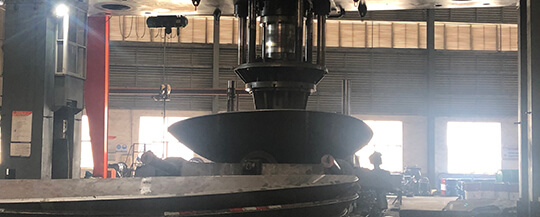The use of spinning technology to manufacture thin-walled container heads has the characteristics of economy, speed and flexibility, and has become the main method of head processing. However, spinning forming is a complicated and continuous partial loading forming process under the action of many factors. There are many influencing factors, and scholars at home and abroad have conducted a lot of research on this process and related equipment. But for the spinning forming of large-diameter and thin-walled aluminum alloy heads, the diameter of the parts and blanks is large, and the wall thickness of the parts is much smaller than the diameter. Therefore, the restraining effect of the undeformed area on the deformed area in spinning forming is weaker than that of small parts. In addition, large thin-walled components are sensitive to fluctuations in the performance and shape and size of the blank, and it is easy to cause local thinning or even breakage during the spinning forming process. The flange instability and wrinkles make the spinning process difficult to proceed smoothly, poor mold fit and springback Large defects, resulting in low accuracy of parts shape and size. This paper uses a combination of finite element numerical simulation and experimental research to study the shear spinning forming process of a large diameter thin-walled aluminum alloy head with a diameter of 2600 mm and a slab thickness of 12 mm. The distribution law of the stress and strain of the workpiece during the shear spinning process and the influence law of the process parameters on the quality of the spinning part are investigated.
Aluminum alloy head shear spinning is a typical forming process: a flat plate or a pre-formed blank is concentrically fixed on the end face of the mandrel through the tail tip, and rotates with the main shaft, and the rotary wheel has a certain gap along the direction of the mandrel's track line The feed movement deforms the material point by point and forms the required workpiece.
Based on the research, the key spinning process parameters are optimized: The larger the radius of the rotary wheel fillet, the greater the uneven deformation of the material and the greater the wall thickness difference, so the rotary wheel fillet R is 12 mm; The greater the feed ratio, the greater the degree of uneven deformation of the material and the extreme difference in wall thickness.
By optimizing the forming parameters, selecting the fillet of the rotary wheel, calculating the feed ratio of the rotary wheel, and the speed of the core mold, the process test was carried out and a spinning head part with a diameter of 2600 mm and a good surface size was obtained.
